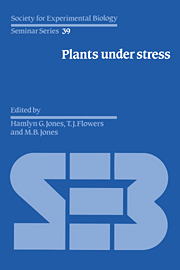Book contents
- Frontmatter
- Contents
- Contributors
- Preface
- 1 Introduction: some terminology and common mechanisms
- 2 The impact of environmental stresses on ecosystems
- 3 Whole-plant responses to stress in natural and agricultural systems
- 4 Photosynthesis and gas exchange
- 5 Regulation of growth and development of plants growing with a restricted supply of water
- 6 Stresses, membranes and cell walls
- 7 Desiccation injury, anhydrobiosis and survival
- 8 Molecular biology: application to studies of stress tolerance
- 9 Environmental control of gene expression and stress proteins in plants
- 10 Plant tissue and protoplast culture: applications to stress physiology and biochemistry
- 11 Breeding methods for drought resistance
- 12 Selection for physiological characters – examples from breeding for salt tolerance
- 13 Prospects for improving crop production in stressful environments
- Index
9 - Environmental control of gene expression and stress proteins in plants
Published online by Cambridge University Press: 16 March 2010
- Frontmatter
- Contents
- Contributors
- Preface
- 1 Introduction: some terminology and common mechanisms
- 2 The impact of environmental stresses on ecosystems
- 3 Whole-plant responses to stress in natural and agricultural systems
- 4 Photosynthesis and gas exchange
- 5 Regulation of growth and development of plants growing with a restricted supply of water
- 6 Stresses, membranes and cell walls
- 7 Desiccation injury, anhydrobiosis and survival
- 8 Molecular biology: application to studies of stress tolerance
- 9 Environmental control of gene expression and stress proteins in plants
- 10 Plant tissue and protoplast culture: applications to stress physiology and biochemistry
- 11 Breeding methods for drought resistance
- 12 Selection for physiological characters – examples from breeding for salt tolerance
- 13 Prospects for improving crop production in stressful environments
- Index
Summary
Introduction
Plants are constantly subject to adverse environmental conditions such as drought, flooding, extreme temperatures, excessive salts, heavy metals, high-intensity irradiation and infection by pathogenic agents. Because of their immobility, plants have to make necessary metabolic and structural adjustments to cope with the stress conditions. To this end, the expression of the genetic programme in plants is altered by the stress stimuli to induce and/or suppress the production of specific proteins which are either structural proteins or enzymes for specific metabolic pathways.
Several problems are addressed in the study of stress-induced proteins: (1) Perception: how does a plant recognise the existence of a stressful condition? (2) Regulation of gene expression: how does the perceived stress signal alter the expression of genes? (3) Function: what are the physiological roles of the stress-induced proteins? Studies designed to answer these questions usually begin with the finding of new proteins in stressed tissues, most likely by gel electrophoretic techniques. This initial observation is followed by purification of the stress proteins, and the cloning and characterisation of their genes. Research on the function of stress proteins has been progressing, although many stress proteins remain unidentified. The least understood process is probably the molecular mechanism underlying the perception of stress signals.
Temperature stress
Due to seasonal changes, almost all plants are affected by temperature fluctuations in their life cycles. Very high temperatures have been reported in many arid zones around the world, and the lack of effective transpiration in plants located in these areas causes the temperatures inside these plants to be significantly higher than ambient (Levitt, 1980). Chilling or subfreezing temperatures are even more common.
- Type
- Chapter
- Information
- Plants under StressBiochemistry, Physiology and Ecology and their Application to Plant Improvement, pp. 157 - 180Publisher: Cambridge University PressPrint publication year: 1989
- 5
- Cited by



